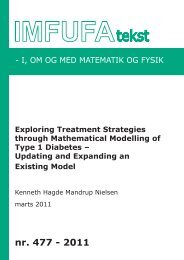ABSTRACT ALGEBRAIC STRUCTURES OPERATIONS AND ...
ABSTRACT ALGEBRAIC STRUCTURES OPERATIONS AND ...
ABSTRACT ALGEBRAIC STRUCTURES OPERATIONS AND ...
Create successful ePaper yourself
Turn your PDF publications into a flip-book with our unique Google optimized e-Paper software.
The prototype example of field extension is the extension from Z to Q (see<br />
E61)<br />
A very important field of fractions is the one resulting from the ring of polynomials<br />
: E62<br />
12: Examples and exercises<br />
Example 22: Words of equal length (see nr 74)<br />
Th relation x and y have the same length is an equivalence relation on the<br />
monoid of words and it is compatible with concatenation En equivalence class<br />
consists of all words of a certain length. This classification is induced by the<br />
homomorphism which is defined to be the length of the word.<br />
Example 23: The semigroup of words (see nr 74)<br />
The set S of words over a given alphabet with concatenation as operation is a<br />
semigroup.<br />
Example 24: The semigroup of words is not a monoid, but ... (see nr 74)<br />
If the semigroup of words is extended with the empty word you will get a<br />
monoid with the empty word as the neutral element.<br />
Example 25: The set of naturals with addition is a semigroup (see nr 74)<br />
The set of naturals with addition is a semigroup<br />
Example 26: The word length is a homomorphism (see nr 74)<br />
The mapping x ↦→ |x| which to a word assigns its length (number of letters) is a<br />
semigroup homomorphism. It can in an obvious way be extended to a monoid<br />
homomorphism<br />
Exercise 27: Greatest common divisor gives a semigroup (see nr 74)<br />
On the integers you have the binary operation x ⊓ y which to x and y assigns<br />
the greatest common divisor of x and y.<br />
Show that Z with this operation is a semigroup.<br />
Exercise 28: Greatest common divisor does not yield a monoid (see nr 74)<br />
Show that the semigroup i X27 is not (the underlying semigroup of) a monoid<br />
Exercise 29: Minimum gives a semigroup (see nr 74)<br />
We define x ∧ y as the minimum of x and y.<br />
73
















